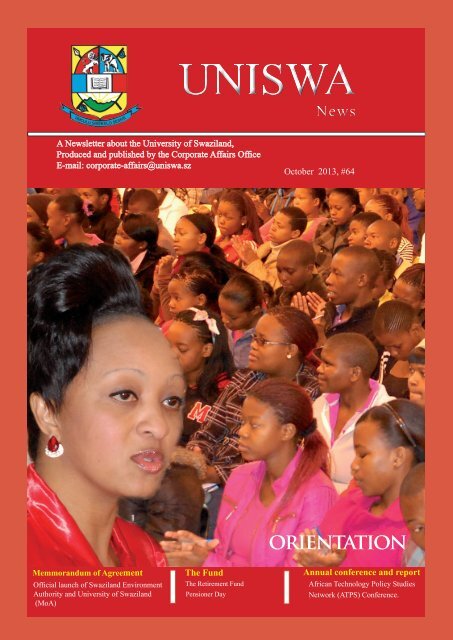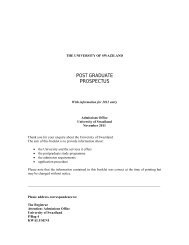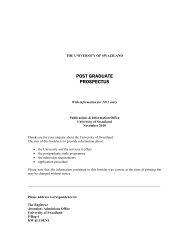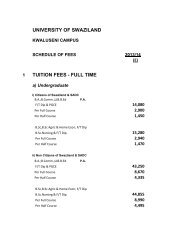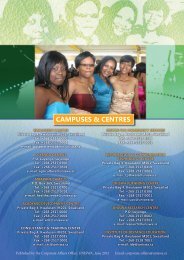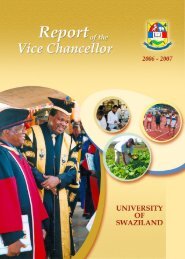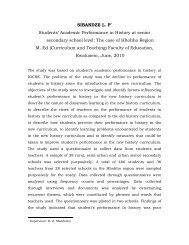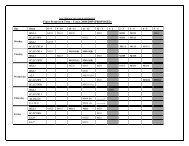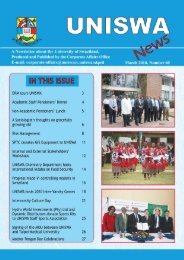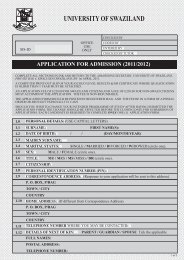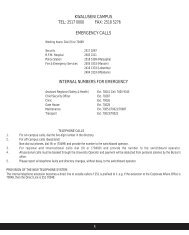UNISWA
October 2013 - University of Swaziland
October 2013 - University of Swaziland
- No tags were found...
You also want an ePaper? Increase the reach of your titles
YUMPU automatically turns print PDFs into web optimized ePapers that Google loves.
<strong>UNISWA</strong>NewsA Newsletter about the University of Swaziland,Produced and published by the Corporate Affairs OfficeE-mail: corporate-affairs@uniswa.szOctober 2013, #64Memmorandum of AgreementOfficial launch of Swaziland EnvironmentAuthority and University of Swaziland(MoA)The FundThe Retirement FundPensioner DayORIENTATIONAnnual conference and reportAfrican Technology Policy StudiesNetwork (ATPS) Conference.
Editor`s noteDear Readers and colleaguesPlease be informed that the publication of the inhousejournal has been revived! It had been temporary pausedbecause of financial constraints. A warm welcome to allstaff and students in 2013/2014 academic year! We wishyou all a productive and rewarding academic year. Theorientation sessions for both full-time and IDE studentshave been successfully held where the Vice Chancellor,Professor Cisco Magagula cordially welcomed thestudents.During the pause, <strong>UNISWA</strong> turned 30. As part of thecommemoration of this milestone, an informativesupplement on the evolution of <strong>UNISWA</strong> is beingpublished by the the Nation Magazine. It will be in theshops in coming months, and it is a must-have!At the beginning of the academic year, the UniversityManagement and the two university unions i.e. theAssociation of Lecturers and Academic Personnel andthe Swaziland Union of Non-Academic Staff for HigherInsititutions reached an agreement to adjust salaries ofstaff by 5%. This financial relief has been pleasantlywelcomed by staff. Members of staff are encouraged tosubmit articles for this quarterly publication. Articlesmay be of any topic of interest to the Universitycommunity.On a sad note, <strong>UNISWA</strong> News wishes topass sincere condolences to families and colleagues oftwo of our retired staff: Dr. Marylen Habedi and Mr.Simon Silenge. May their souls rest in peace!We are proud to introduce to our readers, Mr. FundisoSimelane, a final year Graphic Design student fromLimkokwing University. We hope our partnership willcontribute positively to the Office work. We hope hebenefits from his three months internship programmewith us.If you have our comments or wish to write for us,please email: corporate-affairs@uniswa.sz.Till then.Qinisile MatseCONTENTSOfficial Launch of Swaziland Environment Authorityand University of Swaziland MoA 3SARUA Climate Change Capacity BuildingWorkshop 5ATPS Annual Conference and Workshop inEthiopia 6<strong>UNISWA</strong>-2013/2014- Orientation 7Elections in Swaziland 9The University of Swaziland Pension Fund 12The Role of Planted Pastures in LivestockProduction 15The Social Work Profession 18The African Health Profession RegulatoryCollaborative(ARC) Summative 20Staff News 25Qinisile MatseDr. G.Z. KhumaloDr. N. R. MkhontaDr. P. Q. MagagulaDr. M.A. DubeMr. M. MliphaMr. Z. MabuzaMs. L.P. MabundzaFundiso Simelane650 copiesUniversity Council, Staff,Students, Government Ministries,Education and Training PortfolioCommittee, selected universities in theregion, selected parastatals in Swazilandand the Library of Congress.2<strong>UNISWA</strong> News - October 2013
OFFICIAL LAUNCH OF THE SWAZILAND ENVIRONMENT AUTHORITY(SEA) AND UNIVERSITY OF SWAZILAND (<strong>UNISWA</strong>) MEMMORANDUM OFAGREEMENT (MoA)By Mr. Mandla MliphaProf. Cisko Magagula (<strong>UNISWA</strong>) exchange signed MoA documents with Mr Steven Zuke (SEA). Lookingon are from L to R: Mr D. Khumalo, Prof. V.S.B. Mtetwa and Mr M. MliphaThis was a breakfast function held on July 08,2013 at eSibayeni Lodge in Matsapha to launchthe SEA – <strong>UNISWA</strong> MoA for implementationof the plan to integrate Biotechnology and Biosafetyin programmes and practices in institutions of highereducation and training in Swaziland referred to as themainstreaming plan. In the Agreement, SEA shallprovide the requisite funding for implementation ofvarious activities in the plan and <strong>UNISWA</strong> would providethe requisite expertise to ensure the implementation ofall the activities in the plan and realize the deliverablesstated. The mainstreaming plan is divided into twophases: Phase 1 of the plan contains preliminaryactivities and phase 2 covers the undertaking of severalinstitution-based training workshops on Biotechnologyand Biosafety. The current MoA supports only phase 1of the plan.Participating in the launch were senior representatives ofthe two institutions being the Vice Chancellor, Prof. C.M. Magagula for <strong>UNISWA</strong> and Mr S. Zuke for SEA. Inattendance were senior officers from <strong>UNISWA</strong> includingthe Pro-Vice Chancellor Prof. V.S.B. Mtetwa, and theDirector of University Planning Dr. S.S. Simelane.Important stakeholders in attendance were the NationalSteering Committee on Biotechnology and Biosafetyrepresented by its Chairman Mr. D. Khumalo as wellas the MESA Implementation Committee (MIC) alsorepresented by its Chairman Mr. M. Mlipha (Figure 1).The SEA Representative, Mr. Zuke, gave a briefbackground of the national programme on Biotechnologyand Biosafety and the existence of the nationalbiosafety framework (NBF) which is currently underimplementation with the support of UNEP and GEF(Global Environmental Fund). Some key achievementsin the on-going implementation of the NBF include thepromulgation of the National Biosafety Act of 2012 whileother programme areas within the NBF are at varyingstages of completion and others are at commencementstages. Integration of Biotechnology and Biosafety inlocal education system (schools and higher education)is also a key component requiring implementation inthe NBF. Mr S. Zuke, therefore, thanked <strong>UNISWA</strong> forresponding to the invitation to implement this componentof the NBF. It is anticipated that a similar process willcommence involving the local schools.The Vice Chancellor, on his part, thanked SEA forassociating itself with <strong>UNISWA</strong> not only in the signing<strong>UNISWA</strong> News - October 2013 3
Front row L to R: Mr Dan Khumalo (Chairman of steering committee); Prof. V.S.B. Mtetwa (Pro-Vice Chancellor<strong>UNISWA</strong>); Prof. C.M. Magagula (Vice Chancellor, <strong>UNISWA</strong>); Mr. S. Zuke (Director, Acting Executive Director,SEA); Mr. M. Mlipha (MESA Chair, <strong>UNISWA</strong>)Back row L to R: Dr C.N. Magagula (Biological Sciences, <strong>UNISWA</strong>); Dr T. Ndlovu (Chemistry, <strong>UNISWA</strong>); Ms P.Mdziniso (Min. of Agriculture); Dr T.A.M. Mahlaba (Head, Biological Sciences, <strong>UNISWA</strong>); Mr Ncamiso (SEA); MrI.G. Dladla (SEA); Ms C. Mhlanga (SEA); Mr B. Nkhabindze (SEA); Ms C. Dlaminiof the current MoA but on other activities that havebeen undertaken jointly by the two institutions. Hementioned that <strong>UNISWA</strong>, as an institution, accordssuch collaborations serious attention. He concludedby assuring SEA that <strong>UNISWA</strong> has the capacity andexpertise to deliver on its obligations included in theAgreement. Mr. D. Khumalo, Chairman of the steeringcommittee sounded his committee’s appreciationof the collaboration with <strong>UNISWA</strong> to mainstreamBiotechnology and Biosafety issues in programmes andactivities of higher education institutions. He mentionedthat the mainstreaming plan was presented to thesteering committee and was approved hence the speedyconclusion of the MoA process.Mr M. Mlipha highlighted that the plan will beimplemented by the MESA Implementation Committee(MIC) under the Academic Development Centre at<strong>UNISWA</strong>. The MIC has gained experience in theimplementation of similar projects from its on-goingactivities to mainstream environment and sustainabilityin programmes and practices at <strong>UNISWA</strong> and affiliatedinstitutions. The MIC was constituted by <strong>UNISWA</strong>management in January 2011 to lead the mainstreamingof environment and sustainability at <strong>UNISWA</strong>. MrMlipha further presented the key activities to beimplemented in phase 1 of the mainstreaming planwhich include inter alia audit of existing programmesand practices in relevant institutions to ascertain levelsof integration of Biotechnology and Biosafety issues,production of training materials on Biotechnology andBiosafety, awareness raising seminar for leaders ofinstitutions of higher education and training and others.The launch concluded with the signing and exchangeof the MoA documents between the Vice Chancellorof University of Swaziland and the acting ExecutiveDirector of Swaziland Environment Authority.4<strong>UNISWA</strong> News - October 2013
THE UNIVERSITY OF SWAZILAND, THROUGH ITS MESA CHAIR, HOSTEDTHE SARUA CLIMATE CHANGE CAPACITY BUILDING WORKSHOPBy Mr. Mandla MliphaThe University of Swaziland (<strong>UNISWA</strong>),alongside Universities of Botswana (UB) andZambia (UNZA), was accorded the SADCMESA Chair which was accompanied by seed fundingto support environment and sustainability activities at<strong>UNISWA</strong>. The MESA chair has supported a numberof activities within and outside <strong>UNISWA</strong> includingMozambique. In its existence, the <strong>UNISWA</strong> MSAChair collaborated with other entities, especiallythe SADC-Regional Environmental EducationProgramme (REEP) to host national and regionalmeetings and workshops.On June 06 -07, 2013 the <strong>UNISWA</strong> MESA Chaircollaborated with HEMA (Higher Education AfricaManagement consortium to host the SARUA (SouthernAfrican Regional Universities Association) mappingworkshop on climate change capacity development.The workshop was within the overall Climate ChangeCounts initiative which is intended to strengtheninguniversities’ contributions to climate compatibledevelopmentin southern Africa.Climate compatible development (CCD) is lowcarbon, climate resilient development. The concepthas been developed in recognition of the urgent needfor adaptation, given current climate variability andthe severity of projected climate impacts that willaffect the region; and the need to reduce emissionsas rapidly as possible to avoid more catastrophicclimate change in the future. Thus while CCD can beframed in different ways, given nationally and locallyspecific development trajectories, it does require thatcurrent and future climate risks are mainstreamed intodevelopment, and that both adaptation and mitigationare integral goals of development.In the southern African context, poverty reductionwould be a desired co-benefit. Uncertainties in majordrivers of change, including climate, socio-economicand political risks, necessitate that CCD be viewed as aniterative process, in which vulnerability identificationand risk reduction responses are revised on the basis ofcontinuing learning. Climate compatible developmentopens up new opportunities for interdisciplinary andtrans-disciplinary research, teaching and engagementwith communities, policy makers and practitioners.The participants were drawn from various climatechange stakeholders including a recognisablerepresentation from <strong>UNISWA</strong> while others were fromthe Swaziland Meteorological services, SwazilandEnvironment Authority, Swaziland ElectricityCompany, Komati Basin Water Authority (KOBWA),UNDP, UNESCO, Swaziland National TrustCommission, Teacher Training Colleges, SouthernAfrican University (SANU) to name but a few (Figure1).The participants were welcome to the workshopand <strong>UNISWA</strong> by the Vice Chancellor, Prof. CiscoMagagula. In his remarks the VC mentioned the maincauses of climate change as activities of human beingsand further estimated the proportions of dangers andvulnerabilities due to climate change hence citedthe seriousness of climate change impacts on humanbeings they will remain unmitigated. He concluded bypaying tribute to SARUA and HEMA for undertakingsuch an important and ambitious programme onclimate change and stressed his personal pleasure that<strong>UNISWA</strong>, as a founder member of SARUA is hostingthis important workshop.The official opening addressed was done by thePrincipal Secretary of the Ministry of Education andTraining, Mr Pat Muir, who was representing theHonourable Minister. Mr Muir started his address bystating his personal pleasure to note that the workshopwas well attended and to see a recognisable number ofteachers among the participants. He urged participantsto make their contributions “without fear or favour”so that the outcome of the workshop helps the wholeworld and ensure the mainstreaming of Climate changein the school curriculum. He concluded his addressby encouraging participants to learn from nationsthat are already ahead in addressing climate changeissues and share of information between sciences andhumanities as well as across disciplines. Facilitationof the workshop was conducted jointly by HEMA’sPenny Urquhart and Botha Kruger as well as the<strong>UNISWA</strong> MESA Chair Coordinator Mandla Mlipha.<strong>UNISWA</strong> News - October 2013 5
Prof. A. M. Manyatsi, Ms Thandi Khumalo, Ms DuduNhlengethwa-Masina (Meterology) and Dr. M.A.Dube made presentations on various topics relevantto climate change to provide background details fordeliberations by participants. The workshop alsoused theme and buzz groups to engage participantsin various topics and activities in the workshopprogramme.The official closing of the workshop was done by theVice Chancellor of the University of Swaziland. Inhis closing remarks the Vice Chancellor appreciatedwitnessing the intense deliberations that were takingplace at the moment of his arrival and apologized fordisturbing such. He also congratulated participantsfor maintaining “good” numbers even on the secondand last day of the workshop and mentioned his“hope that various institution’s strategic plans arelikely to come from this meeting … and said “let’scontinue networking to ensure that this project becomessuccessful. Think of this workshop as a starting point forfurther research”.One participant, Mr Ian van Zuydam, passed a vote thankson behalf of the participants. In his remarks he indicatedthe participants’ gratitude to be invited to participate inan enlightening and relevant workshop like the SARUACCD mapping workshop. He further appreciated theopportunity to share ideas with university staff whichthey last met on their days as students at <strong>UNISWA</strong> andother institutions of higher education that participated.He challenged institutions of higher education toinvolve stakeholders in future plans or reviews ofprogrammes they will undertake as well as availing suchopportunities to share ideas between university sectorand stakeholders.The 2012 ATPS Annual Conference & Workshop in EthiopiaBy Dr. Musa M. A. DubeAnnual Conference and Workshop from 19-22October 2012. This Conference and Workshopwas held in Addis Ababa, Ethiopia, organizedby the ATPS Network and hosted by the African Union(AU) in the AU Dr. Musa M. A. Dube attended the 2012African Technology Policy Studies Network (ATPS)Conference Centre. The Conference and Workshopdrew participants from Africa, Europe, India, and UnitedStates of America. The theme of the Conference wasEmerging Paradigms, Technologies and Innovationsfor Sustainable Development: Global Perspectives andAfrican Realities.During the parallel sections, Professor A. M. Dlaminiand Dr. M. M. A. Dube presented a paper on the“Contribution of animal agriculture to green house gasesproduction in Swaziland: Implications for mitigationusing biotechnology. Both Professor Dlamini and Dr.Dube are teaching in the University of Swaziland, Facultyof Agriculture in Animal Science and AgriculturalEducation and Extension, respectively. Dr. Dube had theopportunity to chair one of the parallel sections and theNational Coordinators’ Meeting.Lessons and challenges gained from the Conferencewere many. However, the key ones were: (i) the need tosensitize the public about the value of science, technologyand Innovation (STI) in solving environmental issuessuch as climate change, emission of greenhouse gases;(ii) food insecurity; (iii) the need to deal with and arrestpoverty, and above all, (iv) the need to popularize STI.In addition, Dr. Dube participated in a one day trainingworkshop on Transformational Leadership for theManagement Teams of ATPS. Furthermore, Dr. Dubewas honoured to be appointed Chairman of the ATPSChapter Business Meeting which preceded the workshopand also an important aspect of the Annual ATPSConference and Workshop. Dr. Dube is the NationalCoordinator of the Swaziland Chapter and a regionalCouncil Member for the Southern Africa NationalChapters. Interested individuals, groups, institutions,Networks, associations should contact Dr. Dube formore details at email:madube@uniswa.sz or 25170531(Office) or 7683-1983 (Mobile). In January 2013, thereis going to be Meeting in which ATPS Network will befully explained. Please note this pre-announcement.6<strong>UNISWA</strong> News - October 2013
Orientation 2013Over 1200 prospective students attended the 2013Orientation session. The Dean of Student Affairs hadarranged an interesting and informative programme forthe new students.The Vice Chancellor,Professor C.M. MagagulaThe Matsapha Town BoardChief Executive Officer, Ms.Gciniwe FakudzeDr. I.T. ZwaneThe Vice Chancellor, Professor C.M. Magagulawelcomed the students and shared some thoughts withthem on how to conduct themselves at university. Heinformed them of the composition of the Universitycommunity and how respect was very important for allmembers of the community.Professor Magagula warned them against drug andsubstance abuse. He also told them of the dangers ofHIV and AIDS. The Vice Chancellor invited them to jointhe many student clubs and societies, at the University.Speaking at the same occasion was Ms. GciniweFakudze, the Matsapha Town Board Chief ExecutiveOfficer. She told students to strive for excellence andalways be the best. She gave them some tips on how toachieve excellence.Dr. I.T. Zwane spoke on behalf of parents at theorientation session. She told the new students howparents had struggled to put them where they were andthat they should make them and their communities proudof them. She asked them to concentrate of their studies.Mrs. T. MambaFrom Left: Director IDE; Prof. C.W.S. Sukati, Pro-Vice Chancellor; Prof. V.S.B. Mtetwa, Vice Chancellor; Prof. C.M. Magagula,Matsapha Town Board CEO; Ms. Gciniwe Fakudze and Assistant Dean of Student Affairs(Counselling); Mrs. Thuli Mamba.<strong>UNISWA</strong> News - October 2013 7
<strong>UNISWA</strong> - 2013/2014 - Orientation in pictures8<strong>UNISWA</strong> News - October 2013
ELECTIONS IN SWAZILANDBy Dr. P.Q. MagagulaA Paper Presented At The Faculty Of Social Science Seminar SeriesHeld At The In-Service Conference Room On September 13, 2013The structure of presentation is as follows:I.Definition of electionsII.Emergence of the concept of political electionsIII.Rights are cumulativeIV.The vitality of electionsV.The experience of SwazilandVI.ConclusionI DefinitionPolitical election can be defined as the processwhereby an electorate chooses, by voting, officerseither to act on its behalf, or to represent it in anassembly with a view to forming a government oradministration.The elements of an election are: rules of eligibilityfor candidates, rules for membership of the electorate,voting procedures and officers empowered to enforcethem, laws relating to practice and designed to preventcorruption, intimidation and excessive expenditure orunfair advertising. (R. Scruton 1982)II Emergence of the Concept of Political Elections•The emergence of liberal thinking gave birth to thenew idea of political elections.•Liberal thinking is traced back to the developmentof capitalism in Europe, which superseded feudalism•This is the period between the 17th and 18thcenturies when scholars like J. Locke (1632-1704)and Montesquieu (1689-1755) articulated the liberalphilosophy.•During the period of feudalism, people were regardedas subjects of their rulers (kings, emperors and othernobilities), not citizens.•The reaction of liberal thinking was that people hadnatural rights or God given rights. These rights didnot derive from any mortal being and, therefore, therewas no need to beg anybody for them.•The question was how to guard these rights againstinfringements, since it was no longer possible to havemass rule (mass democracy).•The answer was: every society needed a constitutionand a representative government; a representativegovernment being the rule by a few to whom the massesdelegate their powers.•These few would rule on behalf of the masses, whilethe power and sovereignty lay with the people.•Representative government gave birth to the concept ofpolitical elections in modern societies.•This means that persons who rule are mandated bypeople who are ruled.•For all intents and purposes, the former are answerableto the latter. Their operations are also directed by theconstitution.•It is imperative to note that the transition to this formof rule (political system) was not smooth sailing. Therewere battles. In France the King, Queen and their nobleswere guillotined during the revolution of 1789-1799,and in England King Charles I was beheaded in 1649.•But the struggle to get a fully representative governmentcontinued, because initially it was men of property whoacquired the rights, no women qualified.•Eventually all men and women acquired these rights.•Even nowadays, the struggle for a fully-fledged liberaldemocracy is still continuing.III Rights are cumulative•It is important to note that any democracy that is aliveis growing.•In that sense human rights keep on being added.•With regard to elections we note the following:a)The rights to associate with anybody. This leads tothe formation of groups of people or political parties, asthe case may be, in all societies. The political groupingsrepresent the interests of the people.b)Political parties aspire to win power and form arepresentative government (as elaborated above)c)The people also have a right of choice. They have aright to choose or not to choose.d) The people have freedom of conscience, the right tohold views they feel strongly about.<strong>UNISWA</strong> News - October 2013 9
In other jurisdictions, the replacement ratio is subsidizedby National Social Security Funds/ Grants; howeversince Swaziland’s National Social Security Fund is stillunder development, savings and retirement annuitiesare the solution to a more comfortable retirement. As anindividual, you need to make sure you save during yourworking life by putting away some money or taking outretirement annuities. The person in our example needsto save enough funds to be able to have E 3 500.00 permonth after retiring.Professional financial advisors will prescribe that oneneeds to save at least 10% of your basic salary in orderto live comfortably in the future. This however does notmean that one should not save if less than 10% of yourbasic salary is available to save. Regardless of how littleyou save, it is better than nothing at all.There are saving vehicles in Swaziland that areavailable. These vehicles are with insurance companies,asset management companies and financial institution.When sourcing these service providers, it is veryimportant to make sure that they are legal in Swazilandby confirming their existence with the Registrar ofInsurance and Retirement Fund, 2nd Floor, P. S. P. F.Building, Mbabane.PENSIONER DAYThe Pensioner Day is an event that was introducedin August 2012 dedicated to pensioners of the Fund.This is a special day for the former active members ofthe Fund in which they can interact with each other,share ideas and complete the certificates of existence.Further, the Fund gets an opportunity to have a generalinteraction with the pensioners in order to get their viewsand suggestions on how their lives can be improved.During this event, pensioners are updated on especiallythe financial position of the Fund and prospects of anincrease in their monthly pension as well as any otherrelevant information that they may need to know aboutthe Fund.At the inception event, it was announced that the Fundwas performing well and after consultations with theFund’s actuary, a 5% pension increment was declared bythe trustees on the pensioners’ monthly pension. Further,it was announced that an increase to a minimum of E500.00 would be implemented for all pensioners thatearned less than this amount. These increments wereeffective as of April 2012 therefore the pensioners wereback paid appropriately.The Fund’s pension increase policy is that an increaseis considered based on the financial performance ofthe Fund, such increase is considered every year bythe actuary after ensuring affordability and hencesustainability of the increase in the liability of the Fund.The next Pensioner Day is scheduled for August 2013.The Fund is actively looking for ways in which memberscan have easy access to all relevant information aboutthe Fund. Look out for more information disseminationmediums. Finally, members of the Fund are encouragedthat they should not hesitate to contact the office of theFund for any questions and clarity.Email: zmabuza@uniswa.szPhone: 2517 0120Happy Retirement to the following!Non-Academic StaffNamePositionDepartmentThandiTypistAPHMakhathuRegistry (L)VilakatiTelephonist/FaxOperatorTephu C. DubeTractor DriverCropProductionPhumaphiLibrary (M)DlaminiAssistantSibongileMthimkhuluTypistEducationJohn MoyaneDriverTransport (L)DlaminiPainterMaintenance(K)AmosHlatshwayoPainterMaintenance(L)James Shongwe Head Waiter Refectory (K)GladysNdzabandzabaPer. SecretaryDean’s Office(L)<strong>UNISWA</strong> News - October 2013 13
Pensioner Day Pictures14<strong>UNISWA</strong> News - October 2013
THE ROLE OF PLANTED PASTURES IN LIVESTOCK PRODUCTIONBy Dr. G.Z. Khumalo“…He maketh me to lie downin green pastures.” We are allfamiliar with this Bible phrasefrom Psalms 23:2. We havealso had phrases like “leavingfor greener pastures.” What isspecial with green pastures?Why do we need plantedpastures?In this articlewe will briefly look at thecontribution of planted pastures in livestock production.As humans we utilise livestock and livestock productssuch as meat, milk, cheese and yoghurt. Unless we havepastures, we cannot have these in sufficient amounts.Quality pastures are the powerhouse of any livestockenterprise, whether it is a large commercial operationor a small landholding running limited numbers oflivestock. Healthy pastures mean healthy animals, animportant goal for landholders of any scale.In Swaziland we mainly use planted pastures in dairyproduction. Dairy farming plays an important role inthe production of milk and income generation. Milk isessential in both human nutrition and health; it consistsof 87% water and essential substances to man such asproteins of high biological value, carbohydrates, fats,all B-vitamins, vitamin A, calcium and phosphorus(Bayly, 2011; Mathewman, 1993). Mathewman (1993)referred to milk as a complement for all diets, thereforea valuable source of nutrient for growing children,convalescing adults, pregnant and lactating women andfor sick people as it sustains and nourishes the body. It isused in many recipes and made into milk products suchas cheese, yoghurt, and ice-cream.In Southern Africa including Swaziland, milk istraditionally either consumed raw or allowed to fermentnaturally or sometimes pasteurized prior to consumption(FAO, 1990; Masarirambi et al., 2009). The populationof dairy cows in the country is about 6323, and out ofthese, 474 cows are owned by smallholders that aredistributed in the Swazi Nation Land (SNL) (SwazilandDairy Board, 2009). The rest are kept by commercialmedium and large scale dairy farmers in Title DeedLand (TDL). These animals produce 9 million litres ofmilk in comparison to 56 million litres of milk that isrequired in the country annually and the deficit stands at48 million litres of milk (Swaziland Dairy Board, 2003).ogether with its poor quality resulting in lowproductivity of dairy animals (Premaratne, 2006). Inorder to maximise milk production, it is essential for thefarmer to feed his/her animals with high quality greenfodder. Thus it is necessary for a farmer to first securea well-established planted pasture. Planted pastures arevery important in the dairy industry; they provide forageduring periods of greatest food shortage in the forageflow programme and also high quality green forageduring winter months (Tainton, 2000).Establishment of pastures is costly, thus planted pasturesare used for high valued livestock products (milk).Although it is expensive to establish and maintainplanted pastures in terms of fertiliser and seed costsas well as fencing expenses, a farmer is rewarded withhigh quality product and returns. When compared tocommercial feeds (feed concentrates), pastures providea cheap source of feed for livestock. There are two broadtypes of pastures: natural and planted pastures. Naturalpastures or veld are usually found in areas which arenot suitable for crop production due to many factors, inparticular infertile soils, acid/alkaline soils, undesirabletopography, harsh climates. Hence, their yield andquality are often low. They cannot sustain high yieldinglivestock such as dairy cows. They usually supportlow demanding animals, e.g. beef, sheep, goats andwildlife. On the other hand, planted pastures are usuallyincorporated in cropping systems where conditionsare favourable in terms of rainfall, temperature, soil,topography, etc. Thus they usually compete with arablecrops. They are also expensive to maintain in termsof fertilisers, fences, etc. Hence high valued livestockproducts (milk) are needed for reasonable returns.Pastures are an integral part of dairy farming<strong>UNISWA</strong> News - October 2013 15
There are four types of planted pastures, namelytemporary/emergency forage crop, short term rotationpasture (ley farming), permanent planted pasture andfodder crops. The temporary/emergency forage cropis usually grown over a single growing season, forexample maize for silage or Lucerne for hay. Shortterm rotation pasture (ley farming) is growing crops andpastures in a rotation. The pasture is usually of 3 5 yearsduration and then followed by 2 3 years of crops. Whenthe land is under pasture production, it is said to beresting, and it is time for the land to rebuild its fertilityand soil structure. Permanent planted pasture is plantedand maintained for up to 10 years. When run down,the field is ploughed up and reseeded to a new field ofpasture without incorporating any arable crop. Foddercrops refer to crops grown for livestock production,usually high yielding species of good quality. They areespecially suitable for raising dairy animals in a smallarea of land. They require some form of investmentsuch as high inputs of fertiliser/manure. Some commonfodder species are Napier, forage sorghum, Leucaena andyellow maize. The focus of this article is on permanentand fodder crop types of planted pastures.Growth rates and milk production of animals raisedon natural pastures change greatly during the year.Dairy cows produce more milk during the wet seasonand extremely low milk during the dry season. On theother hand, animals gain weight rapidly during the earlywet season, gain more slowly at the end of the wet andfrequently lose weight during the dry season.The maincause of low productivity is poor quality of feed althoughlow quantity can limit it at the start of the growing season,at high stocking rates and during droughts. Planted(sown) pastures can be highly productive and their useis increasing. They can be used to complement nativepastures and improve the productivity of the wholegrazing enterprise. Sown pastures can help overcomelow productivity by: i. increasing animal productionHarvesting yellow maize for silage makingCows feeding on green chop from yellow maizethrough more and better quality feed, ii. providingmore reliable feed, iii. providing ground cover tomaintain land stability and giving better stock controland reducing cattle handling costs (McIvor et al., 1991;Miller et al., 1991).Provision of more feed and better quality feedPlanted pastures enable stock access to high quality“green” feed throughout the year. Grasses are of lowquality for much of the year because of the stronglyseasonal rainfall and low soil fertility.Legumes on the other hand are of higher quality,especially in old green leaf, dry leaf and stem because ofhigher protein and digestibility levels. This gives betterlive weight gains in summer and a shorter period ofweight loss in winter. In addition, the use of fertilisers,especially N and P, improves pasture quality.Provision of more reliable feedIntroduced species can provide feed when the availabilityor quality of native pastures is low.Many planted grasses stay green until later into the dryseason (winter) and produce green regrowth earlierin spring than native grasses. This helps avoid feedshortages in winter and early spring. The effect of thedeclining maturity of grasses is lessened by legumesor nitrogen-based pastures. Livestock (cattle) can keepgrowing and producing during the early dry season. Theuse of both tropical (summer) and temperate (winter)species is the major way of ensuring reliable feedthroughout the year. Usually the summer species arerainfed while the winter species are irrigated.Many planted species are more nutritious and palatablethan natives. However, there are exceptions. This maybe due to the fact that many planted pasture species16<strong>UNISWA</strong> News - October 2013
have more leaf and less stem material when comparedto native pastures.Maintaining higher stocking ratesPlanted pastures usually provide more feed and highercarrying capacities than native species. The nativegrasses evolved under low grazing pressure and are oftengrazed out at higher stocking rates. Planted grasses canstand heavier grazing and provide herbage where thenative species would decline.Maintaining land stabilityLeaves, growing and dead, protect the soil surface fromthe impact of rain drops, increase infiltration, slow theflow of water over the soil surface andhence reduce soil loss. Planted pasture species canimprove ground cover because they tolerate heaviergrazing and grow better. Where the native grasseshave been grazed out, their seeds last only a short time inthe soil and regeneration would be slow. Planted speciescan revegetate these bare areas.Planted pastures provide more and reliable feed ofbetter qualityIn summary, planted pastures are essential to meet theincreasing local demand for milk and other livestockproducts. Planted pastures satisfy the forage needs ofanimals during periods when the quantity or quality orboth of forage produced by natural pastures is low. Theyincrease the total amount and quality of forage availablefor animal feeding through the year, and they increasethe level of animal production per unit area of land.• Bayly, F. (2011). Importance of milk in our diet. Demand Media.hpp:// www.livestrong.com/21/02/13.• FAO (1990). The Technology of Traditional Milk Production in Developing Countries. FAO Animal Productionand Health Paper: 85, Rome, Italy.• Masarirambi M.T., Mhazo N., Dlamini A.M. and Mutukumira, A.N. (2009). Common Indigenousfermented foods and beverages produced in Swaziland. Journal of Food Science and Technology 46: 505 – 508• Matthewman, R.W. (1993). Dairying. University of Edinburgh, Scotland, UK.• McIvor, J., Bishop, H., McKeague, P. and Middleton, C. (1991). The place for sown pastures. In “SownPastures for the Seasonally Dry Tropics”. Australia.• Miller, C. P., Anning, P., Winter, W. and Wildin, J. (1991). Developing and managing pastures. In “SownPastures for the Seasonally Dry Tropics”. Queensland Department of Primary Industries (QDPI) InformationSeries. Australia.• Premaratne, S. and Premalal, G.G.C. (2006). Hybrid Napier (Pennisetum purpureum X Pennisetumamericrnum) VAR.CO-3: A resourceful fodder grass for dairy development in SRI LANKA. Journal ofAgricultural Sciences 2(1): 200-219.• Swaziland Dairy Board. (2009). Overview of the Dairy Industry in Swaziland. Manzini. Swaziland.• Swaziland Dairy Board. (2003). Overview of the Dairy Industry in Swaziland. Manzini. Swaziland.• Tainton, N. M. (2000). Pasture management in South Africa. Shutter and Shooter, Pietermaritzburg inassociation with University of Natal press.<strong>UNISWA</strong> News - October 2013 17
THE SOCIAL WORK PROFESSIONBy Ms. L.P. MabundzaIn the country of Swazilandsocial work has for a long timebeen seen as an activity that iscarried out by everyone who cares oreven has the time energy to providea service to those who are poor andliving in the margins of society. Thisapproach has led many to believe itis the way it should be. The ‘crisis’in social work is mainly a matter of professionalidentity that impacts on recruitment, retention and theunderstanding of the profession’s basic aims as statedby Asquith, Clark & Waterhouse (2005) and Unison,(2004). Currently in Swaziland we are experiencing acrisis in social work. Asquith et.al. (2004) states thatwhere there is seen to be a ‘crisis’ in social work, it takesa number of forms and includes:•A crisis in professional identity;•The erosion of professional boundaries;•The lack of professional recognition;•A shortage of qualified social workers;•The growth of para-professionals;•The failure to recruit;•High turnover rates and concern at the numbersleaving professional social work in local authoritysettings;•Working conditions;•Much ‘social work’ is being carried out by nonqualifiedworkers/careers;•The lack of resources necessary to allow social workto be effectively practicedIn Swaziland the crisis manifests in terms of ……..Who is a Social Worker?Without a clear understanding of the principles andfundamentals that govern social work one will notappreciate the sensitivity of social issues. There is anurgent need for social work to clarify its professionalidentity and its distinctiveness compared with otherprofessions especially in this country. This needs tobe viewed with reference to the changing nature of therelationship between worker and client as well as thenature of social problems that social workers have todeal with. According to the United States of AmericaNational Association of Social Workers (NASW) 2005,social workers promote social justice, social change withand on behalf of clients (Clark, 2002) as well as helppeople overcome some of life’s most difficult challenges:poverty, discrimination, abuse, addiction, physicalillness, divorce, loss, unemployment, educationalproblems, disability, and mental illness. They helpprevent crises and counsel individuals, families, andcommunities to cope more effectively with the stressesof everyday life. As stated by the NASW (2005), thesensitivity of helping people overcome some of life’smost difficult challenges cannot be entrusted to a noviceor a person who does not have the necessary skills todo so, but requires rigorous and extensive training andor capacity building which is linked to a recognizedprofessional body for accountability.What do social workers do?According to NASW code of ethics, (2005) the primarymission of the social work profession is to enhancehuman well¬being and help meet the basic human needsof all people, with particular attention to the needs andempowerment of people who are vulnerable, oppressed,and living in poverty. A historic and defining featureof social work is the profession’s focus on individualwellbeing in a social context and the wellbeing ofsociety. Fundamental to social work is attention to theenvironmental forces that create, contribute to, andaddress problems in living.Social workers promote social justice and social changewith and on behalf of clients. “Clients” is used inclusivelyto refer to individuals, families, groups, organizations,and communities. Social workers are sensitive to culturaland ethnic diversity and strive to end discrimination,oppression, poverty, and other forms of social injustice.These activities may be in the form of direct practice,community organizing, supervision, consultationadministration, advocacy, social and political action,policy development and implementation, education, andresearch and evaluation. Social workers seek to enhancethe capacity of people to address their own needs. Socialworkers also seek to promote the responsiveness oforganizations, communities, and other social institutionsto individuals’ needs and social problems (ibid).The mission of the social work profession is rooted ina set of core values. These core values, embraced bysocial workers throughout the profession’s history, arethe foundation of social work’s unique purpose andperspective:•service•social justice•dignity and worth of the person•importance of human relationships18<strong>UNISWA</strong> News - October 2013
•integrity•competence.This constellation of core values reflects what isunique to the social work profession. Core values,and the principles that flow from them, must bebalanced within the context and complexity of thehuman experience.Professional Social WorkThe country of Swaziland is awash with challenges,ranging from high poverty levels with 63% of Swazisliving under the poverty datum line of 1 US Dollarper day (Swaziland Household and ExpenditureSurvey, 2010), high HIV and AIDS prevalence ratesof 26%, high unemployment rates with 40% (SDHS,2007) general population and 53% of the youthunemployed (UNDP, 2012) to mention a few. Takinginto consideration the statistics mentioned above, it isimperative for the country to consider professionalizingsocial work to help the nation deal professionallywith such ills in society. It has to be emphasized thatsocial work practice requires knowledge of humandevelopment and behaviour, social, economic andcultural institutions, and of the interaction of all thesefactors. Social work employs a holistic approach inworking with individuals, families, organizations andcommunities; this approach helps to minimize thepiece meal approach that is employed in the differentinterventions that we interact with as a nation.In the United Kingdom, USA, South Africa andother developing countries, Social Workers arehighly trained and experienced professionals. Andonly those who have earned social work degreesare regarded as “professional social workers. ”Thusdoing social work activities or providing servicesdoes not make one a professional social worker. Thisis not in disregard of the activities done by our elderlyand rural communities who are daily responding tothe needs of the poor and marginalized members ofour society, but it is meant to raise consciousness ofthe nation to advantages of professionalizing socialwork and deliberately training and giving skills toindividuals who have the heart of a social worker.of Sociology is proposing to introduce a bachelor ofsocial work stream in its semesterized programme asa way of responding to the void and outcry that existsin the country in terms of the social work profession.It is sad that social work has not been introduced atany tertiary institution in Swaziland yet most of thesocial problems that are facing the country require theexpertise of trained social work professionals. Theneed for this profession is there but no one has takenit upon themselves to support its implementation and<strong>UNISWA</strong> has an opportunity to break ground and be thefirst institution to provide training for social workers.The demand and need for social workers is there andthe work for these professionals will always be there aslong as there are people. The demand for social workersis not a local issue only; even in the developed countriesthere is a huge demand for these professionals. A majorbreakthrough for this country would be to have socialwork introduced at <strong>UNISWA</strong> sooner rather than laterafter all the government has expressed support forindividuals who might be interested in pursuing a socialwork degree outside the country (as one of its priorityareas). The most difficult question that the departmentof sociology has to respond to from stakeholders is“when are you introducing the bachelor of social workdegree?”- we are confident as a department that it won’tbe long before the programme is introduced.In terms of accreditation <strong>UNISWA</strong> is well placed toprovide a social work programme that can be endorsedwithin the region and abroad. It will be very crucial forthe institution to assist in ensuring that graduates aremarketable and credible wherever they go. Providingleadership through training can be shown by <strong>UNISWA</strong> bybeing a pioneer of this essential skill and empowermentof the social welfare workforce in Swaziland. Throughthe Institute of Distance learning the institution can alsotake lead in providing long distance programmes for theworkforce that needs on the job training and/or shortintensive refresher courses. On the other hand there areindividuals who have been the face of social work inSwaziland- those too can benefit from having coursesdesigned specifically for them in order to improve andsharpen their skills as they continue to work with themost vulnerable populations.The role of professional social workers goes beyondjust the heart and the willingness of the worker asaccording to the NASW (2005) “professional socialworkers assist individuals, groups, or communities torestore or enhance their capacity for social functioning,while creating societal conditions favorable to theirgoals.” It is for this reason that the Department<strong>UNISWA</strong> News - October 2013 19
THE AFRICAN HEALTH PROFESSION REGULATORY COLLABORATIVE (ARC)SUMMATIVEBy Dr Nkosazana Ruth MkhontaSwaziland teamIntroductionThe African Health Profession Regulatory Collaborative(ARC) Summative Congress was held on July 30-August2, 2013 in Nairobi-Mayfair Sun, Kenya. The ARC is aninnovative, south-to-south partnership in which nationalNursing and Midwifery teams’ work together to improveprofessional regulations in the east, central and southernAfrican region.THE ARC is a four year Initiative. It is unique in thatit supports regulation improvement projects whichare developed, proposed, and implemented by thenational Nursing and Midwifery leadership teams. Byemphasizing south-to-south collaboration and sharingof resources, the ARC not only advances rapid scale-upof regulatory reform in the region, but also builds longtermcapacity among African professional institutions,resulting in stronger health systems for years to come.The aimThe aim of the ARC is to strengthen the capacity ofNursing and Midwifery regulatory leadership to improvehealth professional standards and practice in the region,using local solutions and peer based learning.The objectives of the summative congress were to:• Facilitate regional dialogue on lessons learned andthe sharing of the best practices in nursing andmidwifery legislation, education standards andpractice regulation.20<strong>UNISWA</strong> News - October 2013• Foster collaboration between nursing and midwiferystakeholders in each country and advance theircollaborative leadership skills.• Promote networking among nursing and midwiferyleadership within the ECSA region and the sharingof good practices in nursing regulation betweencountries.• Provide assistance and technical support to countriesto advance topic identification for their ARC grantproposals linking nursing and midwifery regulationto HIV service provision.• Disseminate WHO norms, standards, and guidelineson health professional education and trainingprovide assistance and technical support to countriesto advance topic identification for their ARC grantproposals linking nursing and midwifery regulationto HIV service provision.PARTNERSThe ARC initiative is supported by the CommonwealthSecretariat; the US Centers for Disease Control andPrevention (CDC) under the US President’s EmergencyPlan for AIDS Relief (PEPFAR); Emory University’sLillian Carter Center for Global health and SocialResponsibility; the East, Central and Southern AfricaHealth Community (ECSA-HC); and the CommonwealthNurses Federation (CNF).
Participants from East, Central and Southern AfricaThe Swaziland Nursing Council also receivedtechnical and financial assistance from thedevelopment partners’ i.e. International center forAIDS Care and treatment (ICAP), Human ResourceAlliance for Africa and JHPEIGO. These partnersassisted with uupdating of the SNC database andprinting of logbooks, Printing of CPD frameworks,reviewing of SNC strategic plan 2013-2018.PARTICIPANTSEighteen countries from the East, Central andSouthern Africa participated representing Ministriesof health, Schools of Nursing and Midwifery, NursingCouncils and Professional associations.SWAZILAND TEAMThe nursing and midwifery representatives fromSwaziland were: Ms Glory Msibi, Registrar of the,Swaziland Nursing Council, Mrs Gladys ThembisileKhumalo, Chief Nursing Officer at the Ministry ofHealth, Dr Ruth Mkhonta, Lecturer at the Universityof Swaziland and Mr Bheki Mamba, President of theSwaziland Nurse’s Association. The team forms a“QUAD”.REGULATION IMPROVEMENT GRANTSThere is an annual competitive process with externalpeer review whereby each country team submitsgrant proposals for financial support, to addressa nationally-identified regulation priority. The ARCinitiative is a four year initiative which started in2011. The grant is $10 000 per year. Swaziland wrotea proposal for the development and formalizationof the Continuing Professional Development (CPD)which is now a requirement for re-certification andlicensure renewal for all nurses practicing in Swaziland.Swaziland was among 5 countries awarded the nationalregulation improvement grant in 2011 for phase one andthese were Lesotho, Malawi, Mauritius, Seychelles andSwaziland). Six countries have received small grants in2012 (Botswana, Kenya, Swaziland, Tanzania, Uganda,and Zimbabwe). The Summative Congress providedan opportunity for those countries to report on theirprogress.The CPD programme funded by ARC was launchedlast year 19 July, 2012. Since then, nurses are expectedto accumulate ten credits points in order to renew theirlicensure. The ARC project has significantly assisted theSwaziland Nursing Council which is a regulatory bodyfor nurses in carrying out its mandate of safeguardingthe health of the public by ensuring that the professionalsrendering the nursing services continuously improveand maintain their knowledge, skills and competenciesthat are legally and ethically acceptable.CONCLUSIONThe ARC project has improved in-country collaboration<strong>UNISWA</strong> News - October 2013 21
among four nursing pillars which form the “QUAD”.The project has assisted countries achieve regulatoryimprovements and learn to mobilize resources tomeet priority needs. The networking among countrieshas enabled them to share ideas, expertise and goodpractices for quality service delivery. The Developmentof the CPD Framework and Standards has been a greatstride for the country by the Swaziland Nursing Council.ISSUES DISCUSSEDDeliverablesThe ARC project has significantly assisted theSwaziland Nursing Council in carrying out its mandateof safeguarding the health of the public by ensuringthat the professionals offering the nursing servicescontinuously improve and maintain their knowledge,skills and competencies that are legally and ethicallyacceptable.To formalize the CPD requirements for licensure renewaland recertification for practicing nurses in Swaziland.OBJECTIVES• To launch the Continuing Professional Development(CPD)Framework/program.• To provide CPD logbooks to all nurses.• To Update the SNC database.• To market the CPD program• To sensitize stakeholders on formalization ofthe CPD requirements for licensure renewal andrecertification.• To monitor and evaluate the program.TECHNICAL ASSISTANCEPartner ICAP assisted in the updating of the SNCDatabase to accommodate the CPD program as well asprinting of the logbooksLEVERAGE OF ARC GRANTS• SNC was able to attract technical and financial supportfrom development partners.• ICAP – Updating of the SNC database and printingof logbooks.• JHYPEIGO- Printing of CPD frameworks.LESSON LEARNT• Updating the SNC database was a very demandingand time consuming activity.• Procurement and installation of the infrastructuretook longer than expected yet it was very paramount.Linking Regulation with HIV Service Provision:The case of Scaling up VMMC in LesothoVMMC in LESOTHO• VMMC implementation started: March 2012• Free VMMC services, integrated into hospitalservices, offered as a comprehensive HIV servicesprevention package• Provided by Doctors, Nurses and CounselorsLinking Regulation with HIV Service Provision: The caseof Scaling up Voluntary Medical Male Circumcision inLesotho.Free VMMC services, integrated into hospitalservices, offered as a comprehensive HIV servicesprevention package. Provided by Doctors, Nurses andCounselors.Role of Nurses in VMMC Service- Task shiftingMALAWILinking regulation to HIV service delivery for OptionB+ PMTCT Program• Adult HIV prevalence of 10.6%²• Estimated 62,000 HIV positive pregnant women• Nursing cadres prescribe ARVs and providemajority of PMTCT services• Fertility rate of 5.7 in Malawi• All clinical and nursing cadres can initiate andfollow-up patients on standard 1st line ART regimensPRE-SERVICE TRAINING• Revision of the NMT syllabus using an evidence-basedapproach (TA from I-TECH)• In December 2011, NMCM requested technicalassistance to conduct a task analysis• Key gaps in specific syllabus content included HIVrelated competencies and the need for alignmentwith national guidelines• Gaps were noted in clinical teaching• Key findings used to revise NMT syllabus• In 2012-2013 10 CHAM colleges were supported torevise NMT core curriculum to align with revisedsyllabus• Other HRH activities include:• Bursary support to increase production of nurses(PEPFAR)• Capacity building of faculty and preceptors (I-TECHand ICAP TA)• RN syllabus and curriculum to be revised (I-TECH andICAP TA)•Support to clinical teaching, including skills laboratories,optimizing clinical placements (ICAP.If HIV positive, offer Option B+:• Enrolled in HIV care for• Pre-ART, with later ART initiationOR• ART initiation during same visit22<strong>UNISWA</strong> News - October 2013
ENHANCING WORKFORCE PERFORMANCE• Ongoing capacity building of ART sites by MOH• Quarterly site visits for supportive supervision:• Case management, data validation and physicalinventory verification for HIV commodities• Clinical mentoring program:• Targeted mentoring of poor performing sites on thebasis of supportive supervisory visits• Sites can graduate from mentoring support• CPD program for nurses under development• Presents an opportunity for HIV related moduledevelopment, reinforcing core PMTCT competenciesSOUTH AFRICAThabile MsilaHow Nurse Initiated ART (NIMART) increased accessto HIV services in South Africa. This approach toservices deliveryThe impact of NIMART on Access to ARTSince NIMART:• There has been an increase in the number ofHealth facilities providing ART (Presidentialmandate)• There has been an increase in ART uptake• A randomised trial at two SA clinics showed thatnurse monitored ART patients is non-inferior todoctor monitored ART• Nurse initiated ART has increased access to ARTservices in SA• Nurse centred care of HIV patients can be just assafe and effective as care delivered by doctors• Regulation can be an enabler or barrier in HIVservice provisionSwaziland DeliverablesThe Swaziland team presented the following achievementwhich they obtained through awarded regulatoryimprovement grants of $10000; Official launching of theContinuing Professional Development (CPD) programby Swaziland Nursing Council, strengthening of theSwaziland Nursing Council database using the lifelongweb-based system and easy tracking by all relevantstakeholders of CPD activities undertaken by individualnurses each year for recertification and renewal ofpracticing license.ISSUES discussed under Nursing educationThe new regional Road Map for Scaling up theHealth Workforce (2012–2025)• Adopted during the 2012 Regional committee ofMinisters of Health held in Luanda, Angola• The goal of the Road map is to ensure that skilled andmotivated health workers are available to provideuniversal access to health care in the African Region.Scaling up education and training of health workers:priority interventions• Increase educational capacity to scale up productionHW to match demand• Increase production of HWs considering skill mixfor quality of service delivery.• Innovative approaches including ICT, e-learning,inter- professional education and CPD.• Develop national accreditation systems for all healthprofessional institutions.• Increase access to training resources & materialsfor education & development through mechanismssuch as AFRITEX• Expand and strengthen service platforms forprofessional education, training & research.• Promote and facilitate the sharing of education andtraining capacity across the region.•• Promote and facilitate the harmonization of curricula,education standards, accreditation, and professionalregulation.Strengthen training and career progression of teachingstaff with measures for retention• Relevant competency-driven curriculum design &deliveryRoad map RESOLUTION: AFR/RC62/WP/3WHO as secretariat (with its partners) in terms ofregulation and education and training of HWs:• to orient and facilitate harmonization of curriculaof training schools namely the efforts of regionaleconomic communities;• to facilitate the south-south cooperation to respondto the needs of training institutions and strengtheningof regulatory systems;Implications of the global & regional orientations onnursing & midwifery services• Nursing and midwifery component of the workforceis the largest• Advocacy for implementation of nursing &midwifery interventions consistent with scale upinterventions of the roadmap & PHC reorientationto achieve universal access to health care• Inclusion of these processes into the national nursingand midwifery strategic plans to ensure successfulimplementationHealth service delivery• sufficient in numbers,• appropriate in skill mix,• competent,<strong>UNISWA</strong> News - October 2013 23
• Well performing & productive,• and responsiveTransforming and Scaling up Health ProfessionalEducation and TrainingTransforming and scaling up the education and trainingof health professionals recommendations: what is it?A series of policy recommendations that addresses thequantity, quality and relevance of health professionalsand contributes to improving population healthoutcomes.Education and Training Institutions 1Faculty development programmes• Education and training institutions should considerdesigning and implementing faculty developmentprogrammes to update and strengthen teaching andclinical skills of faculty members relevant to theevolving health-care needs of communities.increase the socio-economic, ethnic and geographicaldiversity of students.CPD Faculty• Continuous development programmes for facultyand teaching staff, including current health workers,which update and develop teaching skillsStreamlined pathways• Streamlined educational pathways, or ladderprogrammes, for the advancement of practicinghealth professionals, should be used in bothundergraduate and postgraduate programmes.Higher education policies• Governments, funders and accrediting bodiesshould consider support- ing the implementationof higher education policies for mandatory facultydevelopment programmes that are aligned with thegoal of relevant health professional education .Innovative expansion• Education and training institutions should considerinnovative expansion of faculty, through therecruitment of community-based clinicians andhealth workers as educatorsEducation and Training Institutions 2Faculty development programmes• Education and training institutions should consideradapting curricula to population needs throughidentifying and defining the core competenciesthat are required to meet the evolving needs ofpopulations, health systems and health servicesdelivery and incorporating these into core curricula• Education and training institutions should usecontextually appropriate simulation methodsmore systematically in the education of healthprofessionals.• Education and training institutions should considerdirect entry of graduates from relevant undergraduate,postgraduate or other educational programmes intodifferent or other levels of professional studiesEducation and Training 3Targeted admissionsTargeted admissions policies should be adopted to24<strong>UNISWA</strong> News - October 2013
Staff NewsStaff members with new qalifications -Academic.NAMEDr Jeremiah S. ShelembeDr Thabile NdlovuMs Nomathemba C. NxumaloMs Sakhile K.S. Masuku-MasekoMr Bonginkhosi M. GinindzaMs Letsiwe L. MabuzaDr E.M. SoneDEPARTMENTQUALIFICATIONConsumer SciencePhD (University of Pretoria)ChemistryPhD (University of Johannesburg)Community Health Nursing MA (University of Botswana )Community Health NursingMA (Taipei Medical University)RegistryDip (Theological Education byExtension College)Consumer ScienceMasters Degree in ConsumerScienceAfrican Languages and LiteratureCongratulations to the following staff members on their new appointments! -Academic.NameMs Zanele Sonto DlaminiDr Sabelo Boyie DlaminiMr Mfundo Ntsandvo MsibiProf. Henry Raphael Mloza-BandaMrs Siphiwe M. MahommedMr Leonard Mandla MhlangaMrs Khanyisile N. DlaminiMs Thulisile G. DlaminiDr Mekonnen Shiferaw AyanoPositionDirectorLecturerTeaching AssistantLecturerLecturerLecturerLecturerLecturerLecturerDepartmentConsultancy and Training CentreEducational Foundations&AccountingCrop ProductionJMCEnglish Language and LiteratureACSEnglish Language and LiteratureMathematicsCongratulations to the following staff members on their new appointments! Non-Academic.NameMpendulo NdzinisaNtokozo MambaNomcebo NgwenyaLetsiwe DlaminiPositionDatabase OfficerDatabase OfficerTechnologistStoresladyDepartmentAdmin (HR)Admin (HR)ChemistryRefectory (L)All the best for staff on training! Non-Academic.NamePositionDepartment<strong>UNISWA</strong> News - October - 2013 2013 25A
Staff NewsCongratulations to staff with new qualifications! Non-Academic.NameZodwa MkhaliphiDolly NdzabandzabaNtfombi DubeSheila NdabaSimon MaphangaSibongile VilakatiStanley S. SimelanePositionSnr. Per.SecPersonal Sec.Personal Sec.Snr. Per. Sec.Printshop ManagerPersonal Sec.TechnicianQualificationsDiploma in Human ResourcesManagementDiploma in Human ResourcesManagementBA in Adult EducationBA in Adult EducationMA in EducationBA in HumanitiesBSc in Land & WaterManagement26<strong>UNISWA</strong> News - October 2013


